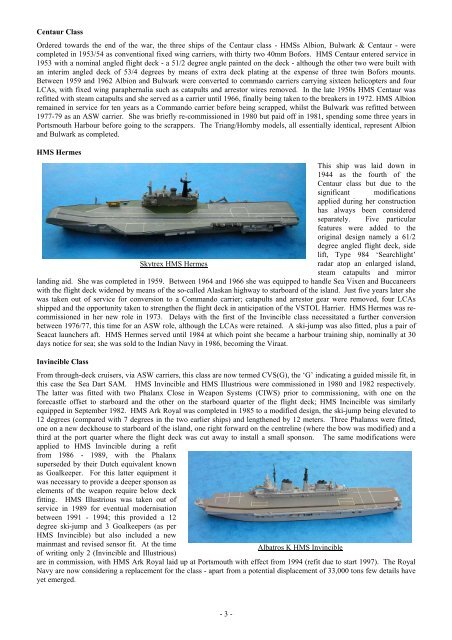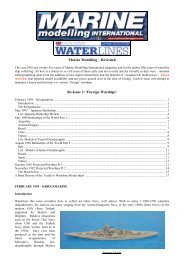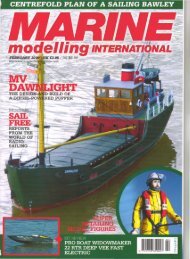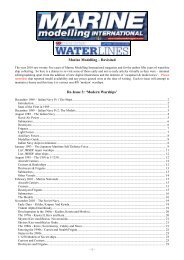Marine Modelling – Revisited Re-Issue 5 - Traplet Publications
Marine Modelling – Revisited Re-Issue 5 - Traplet Publications
Marine Modelling – Revisited Re-Issue 5 - Traplet Publications
You also want an ePaper? Increase the reach of your titles
YUMPU automatically turns print PDFs into web optimized ePapers that Google loves.
Centaur Class<br />
Ordered towards the end of the war, the three ships of the Centaur class - HMSs Albion, Bulwark & Centaur - were<br />
completed in 1953/54 as conventional fixed wing carriers, with thirty two 40mm Bofors. HMS Centaur entered service in<br />
1953 with a nominal angled flight deck - a 51/2 degree angle painted on the deck - although the other two were built with<br />
an interim angled deck of 53/4 degrees by means of extra deck plating at the expense of three twin Bofors mounts.<br />
Between 1959 and 1962 Albion and Bulwark were converted to commando carriers carrying sixteen helicopters and four<br />
LCAs, with fixed wing paraphernalia such as catapults and arrestor wires removed. In the late 1950s HMS Centaur was<br />
refitted with steam catapults and she served as a carrier until 1966, finally being taken to the breakers in 1972. HMS Albion<br />
remained in service for ten years as a Commando carrier before being scrapped, whilst the Bulwark was refitted between<br />
1977-79 as an ASW carrier. She was briefly re-commissioned in 1980 but paid off in 1981, spending some three years in<br />
Portsmouth Harbour before going to the scrappers. The Triang/Hornby models, all essentially identical, represent Albion<br />
and Bulwark as completed.<br />
HMS Hermes<br />
This ship was laid down in<br />
1944 as the fourth of the<br />
Centaur class but due to the<br />
significant modifications<br />
Skytrex HMS Hermes<br />
applied during her construction<br />
has always been considered<br />
separately. Five particular<br />
features were added to the<br />
original design namely a 61/2<br />
degree angled flight deck, side<br />
lift, Type 984 ‘Searchlight’<br />
radar atop an enlarged island,<br />
steam catapults and mirror<br />
landing aid. She was completed in 1959. Between 1964 and 1966 she was equipped to handle Sea Vixen and Buccaneers<br />
with the flight deck widened by means of the so-called Alaskan highway to starboard of the island. Just five years later she<br />
was taken out of service for conversion to a Commando carrier; catapults and arrestor gear were removed, four LCAs<br />
shipped and the opportunity taken to strengthen the flight deck in anticipation of the VSTOL Harrier. HMS Hermes was recommissioned<br />
in her new role in 1973. Delays with the first of the Invincible class necessitated a further conversion<br />
between 1976/77, this time for an ASW role, although the LCAs were retained. A ski-jump was also fitted, plus a pair of<br />
Seacat launchers aft. HMS Hermes served until 1984 at which point she became a harbour training ship, nominally at 30<br />
days notice for sea; she was sold to the Indian Navy in 1986, becoming the Viraat.<br />
Invincible Class<br />
From through-deck cruisers, via ASW carriers, this class are now termed CVS(G), the ‘G’ indicating a guided missile fit, in<br />
this case the Sea Dart SAM. HMS Invincible and HMS Illustrious were commissioned in 1980 and 1982 respectively.<br />
The latter was fitted with two Phalanx Close in Weapon Systems (CIWS) prior to commissioning, with one on the<br />
forecastle offset to starboard and the other on the starboard quarter of the flight deck; HMS Incincible was similarly<br />
equipped in September 1982. HMS Ark Royal was completed in 1985 to a modified design, the ski-jump being elevated to<br />
12 degrees (compared with 7 degrees in the two earlier ships) and lengthened by 12 meters. Three Phalanxs were fitted,<br />
one on a new deckhouse to starboard of the island, one right forward on the centreline (where the bow was modified) and a<br />
third at the port quarter where the flight deck was cut away to install a small sponson. The same modifications were<br />
applied to HMS Invincible during a refit<br />
from 1986 - 1989, with the Phalanx<br />
superseded by their Dutch equivalent known<br />
as Goalkeeper. For this latter equipment it<br />
was necessary to provide a deeper sponson as<br />
elements of the weapon require below deck<br />
fitting. HMS Illustrious was taken out of<br />
service in 1989 for eventual modernisation<br />
between 1991 - 1994; this provided a 12<br />
degree ski-jump and 3 Goalkeepers (as per<br />
HMS Invincible) but also included a new<br />
mainmast and revised sensor fit. At the time<br />
of writing only 2 (Invincible and Illustrious)<br />
are in commission, with HMS Ark Royal laid up at Portsmouth with effect from 1994 (refit due to start 1997). The Royal<br />
Navy are now considering a replacement for the class - apart from a potential displacement of 33,000 tons few details have<br />
yet emerged.<br />
- 3 -<br />
Albatros K HMS Invincible







